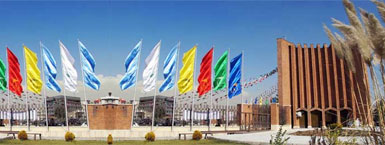
- BS/BA: Nutrition Sciences
- MS: Food Science and Technology
- PhD: Food Science
- Phone: 48292321
- Fax: 48292200
- Email: sabbasifood@modares.ac.ir
- Resume Download
Soleiman Abbasi's CV PERSONAL INFORMATION: Name: Soleiman Abbasi Date of Birth: 21, 03, 1968 Place of Birth: Tabriz–Iran Marital Status: Married
ACADEMIC EXPERIENCES: Associate Professor, Tarbiat Modares University, Tehran–Iran, 2009–continues; Visiting Professor, University of Manitoba, Winnipeg, Canada, Sep 2014–Aug 2015; Assistant Professor, Tarbiat Modares University, Tehran–Iran, 2004–2008; Teaching Assistant, Leeds University, Leeds–UK, 2000–2003; Production Manager, Sobal (Pegasus) Food Industry, Tabriz–Iran, 1998–1999; Junior Lecturer & Researcher, NNFTRI, Tehran–Iran, 1994–1998; Junior Lecturer, Azad University, Tehran–Iran, 1995–1998; Food Catering Manager, Defense Industries Organization (Chamran Hospital),Tehran–Iran, 1992–1994.
MEMBERSHIP IN SCIENTIFIC SOCIETIES: Canadian Institute of Food Science and Technology (CIFST); American Chemical Society (ACS); Institute of Food Technologists (IFT); Iranian Food Science & Technology Association (IFSTA); Member of National Scientific Board of Food Science & Technology (Ministry of Health, Iran); Iran Medical Council; REFEREE FOR SCHOLARLY JOURNALS: Most of peerly reviewed international journals namely: Food Hydrocolloids, Food Chemistry, Journal of Agricultural and Food Chemistry, International Journal of Food Science and Technology, Innovations in Food Science and Technology, Journal of Texture Studies, and many others EDITORIAL MEMEBR: Journal of Food Science and Technology (TMU); Research and Innovation in Food Science and Technology (RIFST-Mashhad); Research in Food Industry (Uromia University); International Journal of Applied Agricultural Research; AWARDS: Nominated as a top researcher for publishing invaluable research papers in highly cited international journals (top 10's in ISI list), Tarbiat Modares University, 2005, 2008, 2014, 2015, 2016; Distinguished teachers award, Post Graduate Students Association, Tarbiat Modares University, Tehran, Iran (2010, 2014); Winner of the First Chocolate Conference Prize for presenting the high quality research report on production of prebiotic chocolate, Tehran-Iran (2008);
Nominated by the Ministry of Science, Research & Technology (European Branch based in London) as an outstanding PhD student, 29–30 June 2002, Birmingham–UK; Nominated as the best poster presentations in the 11th International Gums and Stabilizers for the Food Industry Conference, 2–6 July 2001, Wrexham–UK; Elected jointly by The Iranian Food Science & Technology Association (IFSTA) and Food Agriculture Organization (FAO) for achieving the highest rank in national food science and technology students competition, 10 October 1991, Tehran–Iran. RESEARCH INTERESTS: Food Colloids and Rheology; Food Processing and Engineering (thermal and non-thermal novel food processing technologies); Formulation of Functional Food Ingredients (encapsulation, nanoemulsions, microemulsion technique); PAPERS PUBLISHED IN PEERLY REVIEWED INTERNATIONAL JOURNALS: Abbasi, S.,and Scanlon, M.G. (2017). Nanostructural characterization of orange peelessential oil microemulsions using ultrasonic resonance technology. Journal of Agricultural and Food Chemistry, (in preparation). Perven, S., Scanlon, M.G., and Abbasi, S. (2017). Characterization of bovine serumalbumin–potassium halides interaction using ultrasonic resonator technology. Journal of Protein, (in preparation). Behbahani, M.S., and Abbasi, S. (2017). Stabilization of Persian refreshing drinkcontaining London rocket (Sysymbrium irio L.) seeds. Food Bioscience, (Under revision). Harouni, A., and Abbasi, S., (2017). Decontamination of egg shell by microwaveassisted low pressure cold plasma (LPCP). International Journal of Food Microbiology,(submitted). Samari Khalaj, M., Abbasi, S. (2017). Solubilisation of Persian gum: chemicalmodification using acrylamide. International Journal of Biological Macromolecules, (submitted). Dabestani M, Kadkhodaee R, Phillips GO, Abbasi S. Persian gum: A comprehensivereview on its physicochemical and functional properties. Food Hydrocolloids, under review.
Abbasi S. (2017). Challenges towards characterization and application of a novelhydrocolloid. Current Opinion in Colloid and Interface Science, under review. Abbasi, S. (2017).Persian gum: A novel natural hydrocolloid.Nutrition and Food Sciences Research, 4 (1): 1–2. Teimouri, Sh., and Abbasi, S. Scanlon, M.G., (2017). Stabilization mechanism ofvarious inulins and hydrocolloids: milk–sour cherry juice mixture. International Journal of Dairy Technology, (in press). Mohammadi, S., Abbasi, S., and Scanlon, M.G. (2016). Development of emulsifyingproperty in Persian gum using octenyl succinic anhydride (OSA). International Journal of Biological Macromolecules, 89: 396–405. Abbasi, S.,& Radi, M. (2016). Food grade microemulsion systems: canolaoil/lecithin:n-propanol/water. Food Chemistry, 194: 972–979. Azarikia, F., and Abbasi, S. (2016). Mechanism of soluble complex formation of milkproteins with native gums (tragacanth and Persian gum). Food Hydrocolloids, 59: 35–44. Azarikia, F., and Abbasi, S. (2016). Efficacy of whey protein–tragacanth onstabilization of oil-in-water emulsions: Comparison of mixed and layer by layer methods. Food Hydrocolloids, 59: 26–34. Teimouri, Sh., Abbasi, S., and Sheikh, N. (2016). Effects of gamma irradiation onsome physicochemical and rheological properties of Persian gum and gum tragacanth. Food Hydrocolloids, 59: 9–16. Amiri Rigi, A., and Abbasi, S. (2016). Microemulsion-based lycopene extraction: Effectof surfactants, cosurfactants and pretreatments. Food Chemistry, 197: 1002–1009. Amiri Rigi, A., Abbasi, S. and Scanlon, M.G. (2016). Enhanced lycopene extractionfrom tomato industrial waste using microemulsion technique: Optimization of enzymatic and ultrasound pre-treatments. Innovative Food Science & Emerging Technologies, 35: 160–167. Esmaeilzadeh Nasiri, M, and Abbasi, S. (2016). Effect of Hydrocolloids and DryingConditions on Stability, Rheological and Sensory Properties of Reconstituted Yoghurt (Instant Yoghurt). Focusing on Modern Food Industry (FMFI), 5: 6–15.
Azarikia, F., Wu, B., Abbasi, S., and McClements, D.G. (2015). Stabilization ofbiopolymer microgels formed by electrostatic complexation: Influence of enzyme (laccase) cross-linking on pH, thermal, and mechanical stability. Food Research International, 78: 18–26. Mirmajidi Hashtjin, A., and Abbasi, S. (2015). Optimization of ultrasonic emulsificationconditions for the production of orange peel essential oil nanoemulsions. Journal of Food Science and Technology, 52: 2679–2689. Mirmajidi Hashtjin, A. and Abbasi, S. (2015). Nano-emulsification of orange peelessential oil using sonication and native gums. Food Hydrocolloids, 44: 40–48. Abbasi, S. & Saeedabadian, A. (2015). Influences of lactose hydrolysis of milk andsugar reduction on some physical properties of ice cream. Journal of Food Science and Technology, 52: 367–374. Abbastabar, B., Azizi, M.H., Adnani, A., and Abbasi, S. (2015). Determining andmodeling rheological characteristics of quince seed gum. Food Hydrocolloids, 43: 259– 264. Hosseinzadeh Samani B., Khoshtaghaza M. H., Minaee S., and S. Abbasi (2015)Modeling the Simultaneous Effects of Microwave and Ultrasound Treatments on Sour Cherry Juice Using Response Surface Methodology. J. Agr. Sci. Tech. 17: 837–846. Farahani G., Ezzatpanah H., and Abbasi S. (2014). Characterization of Siahmazgicheese, an Iranian ewe’s milk variety: Assessment of physico-chemical, textural and rheological specifications during ripening. LWT - Food Science and Technology, 58: 335–342. Ghasemi, S., and Abbasi, S. (2014). Formation of natural casein micelle nanocapsuleby means of pH changes and ultrasound. Food Hydrocolloids, 42: 42–47. Alighourchi, H., Barzegar, M., Sahari, M.A., and Abbasi, S. (2014). The effects ofsonication and gamma irradiation on the inactivation of Escherichia coli and Saccharomyces cerevisiae in pomegranate juice.Irannian Journal of Microbiology, 6:51–58. Alighourchi, H., Barzegar, M., Sahari, M.A., and Abbasi, S. (2013). Effect ofsonication on anthocyanins, total phenolic content, and antioxidant capacity of pomegranate juices. International Food Research Journal, 20: 1703–1709.
Radi, M., Abbasi, S., Hamidi, Z., and Azizi, MH. (2013). Development of a newmethod for extraction of canola oil using lecithin based microemulsion systems. Agro FOOD Industry Hi Tech, 24 (5): 70–73. Hossenzadeh Samani, B., Khoshtagaza, M.H., Minaei, S., and Abbasi, S. (2013). Effect of ultrasonic waves on pasteurization of sour cherry juice. International Journal of Biosciences, 3: 193–200. Abbasi S., and Mohammadi S. (2013). Stabilization of milk–orange juice mixture usingPersian gum: Efficiency and mechanism. Food Bioscience, 2: 53–60. Berenji Ardestani S., Sahari M.A., Barzegar M., Abbasi S. (2013). Somephysicochemical properties of Iranian native barberry fruits (abi and poloei): Berberis integerrima andBerberis vulgaris. Journal of Food and Pharmaceutical Sciences, 1: 67–74. Motavali A., Najafi Gh. H., Abbasi S., Minaei S. and Ghaderi A. (2013). Microwave–vacuum drying of sour cherry: comparison of m. mathematical models and artificial neural networks.J Food Sci Technol, 50 : 714–722. Saberian H., Hamidi-Esfahani Z. and Abbasi S. (2013). Effect of pasteurization andstorage on bioactive components of Aloe vera gel. Nutrition & Food Science, 43: 175– 183. Amiri S., Abbasi S., Ezzatpanah H., and Hosseini E. (2013). Nanocapsulation oforange peel oil using microemulsion technique. Agro FOOD Industry Hi Tech, 24: 44–47. Badamchi, M., Hamidi-Esfahani, Z., Abbasi, S. (2013). Comparison of PhytaseProduction by Aspergillus Ficuum under Submerged and Solid State Fermentation Conditions. Focusing on Modern Food Industry (FMFI), 2: 129–137. Mohammadizadeh M, Hamidi-esfahani Z, Abbasi S, Moradi M, Tanabandeh F. (2012). Isolation and identification of cellulolytic fungi from the soil and optimization ofcellulolytic activities of Aspergillus niger MZM 98-a2. Current Topics in Biotechnology, 7:71–7. Ghaderi A., Abbasi S., Motevali A., and Minaei S. (2012). Comparison ofmathematical models and artificial neural networks for prediction of drying kinetics of mushroom in microwave–vacuum drier. Chemical Industry and Chemical Engineering
Quarterly, 18 (2): 283–293. Nouri M. , Ezzatpanah H., Abbasi S., Aminafshar M., and Behmadi H., (2012). Effect of partially hydrolyzed kappa-casein on physicochemical and sensory properties of heated milk. Journal of Dispersion Science and Technology, 33: 1204–1209. Samadlouie H.R., Hamidi-Esfahani Z., Alavi S.M., Soltani-Najafabadi M., Sahari M.A., and Abbasi S. (2012). Statistical approach to optimization of fermentativeproduction of oil and arachidonic acid from Mortierella alpine CBS 754.68. African Journal of Microbiology Research, 6: 1559–1567 Nouri M., Ezzatpanah H., and Abbasi S. (2011). Application of renneted skim milk as afat mimetics in nonfat yoghurt. Food and Nutrition Sciences, 2: 541–548. Abbasi, S.and Azari, S. (2011). Efficiency of novel iron microencapsulationtechniques: fortification of milk. International Journal of Food Science and Technology, 46: 1927–1933. Saremnezhad, S., Azizi, M.H., Barzegar, M., Abbasi, S., and Ahmadi, E. (2011). Properties of a new edible film made of faba bean protein isolate. Journal of Agricultural Science and Technology, 13: 181–192. Raki-Salimi, K., Hamidi, Z. and Abbasi, S. (2011). Statistical optimization ofarachidonic acid production. Iranian Journal of Biotechnology, 9: 87–93. Dehghan-Shoar, Z., Hamidi, Z., and Abbasi, S. (2010). Effect of temperature andmodified atmosphere on quality preservation of Sayer date fruits. Journal of Food Processing and Preservation, 34: 323–334. Azarikia, F., and Abbasi, S. (2010). On the stabilization mechanism of Doogh (Iranianyoghurt drink) by gum tragacanth. Food Hydrocolloids, 24: 358–363. Farzanmehr, H. and Abbasi, S. (2009). Effects of inulin and bulking agents on somephysicochemical, textural, and sensory properties of milk chocolate. Journal of Texture Studies, 40: 536–553. Abbasi, S.,and Farzanmehr, H. (2009). Optimization of formulation of prebiotic milkchocolate based on rheological properties. Food Technology and Biotechnology, 47: 396–403. Abbasi, S.and Azari, S. (2009). Novel microwave–freeze drying of onion slices. International Journal of Food Science and Technology, 44: 974–979. Abbasi, S.,Rahimi, S. and Azizi, M.H. (2009). Influence of microwave-microencapsulated citric acid on some sensory properties of chewing gum. Journal of Microencapsulation,26: 90–96. Chizari, M., Jannat, S., and Abbasi, S. (2008). Role of extension in developing dairyfarmers Knowledge toward milk quality in Golpayegan township, Iran. American_Eurasian Journal of Agriculture and Environment. 3(3): 333–338. Alighourchi, H., Barzegar, M. and Abbasi, S. (2008). Effect of gamma irradiation onthe stability of anthocyanins and shelf-life of various pomegranate juices. Food Chemistry, 110: 1036–1040. Alighourchi, H., Barzegar, M. and Abbasi, S. (2008). Anthocyanins characterization of15 Iranian pomegranate (Punica granatum L.) varieties and their variation after cold storage and pasteurization. European Food Research and Technology A, 227: 881– 887. Abbasi, S. and Rahimi, S. (2008). Microwave-assisted encapsulation of citric acidusing hydrocolloids. International Journal of Food Science and Technology, 43: 1226– 1232. Abbasi, S.(2005). Influence of acidification and surfactants on gelation of skimmedmilk powder dispersions under high hydrostatic pressure. ICFPTE, 2: 660–668. Abbasi, S., Zandi, P., & Mirbagheri, E. (2005). Quantitaion of limonin in Iranian orangejuice concentrates using HPLC and spectrophotometric methods. European Food Research & Technology, 221: 202–207. Abbasi, S.& Dickinson, E. (2004). Gelation ofi-carrageenan and micellar caseinmixtures under high hydrostatic pressure. Journal of Agricultural & Food Chemistry, 52, 1705–1714. Abbasi, S.& Dickinson, E. (2003). Interaction of micellar casein andi-carrageenan:influence of high pressure. High Pressure Research, 23, 71–75. Fallahi, E., Kimiagar, M., Valaei, N., & Abbasi, S. (2003). Effect of fortified flour withferrous sulfate and with Na2EDTA on iron deficiency anemia and serum zinc. Journal of Food, Agriculture & Environment, 3–4, 69–71. Abbasi, S.& Dickinson, E. (2002). Induced rheological changes to low methoxyl pectinplus micellar casein mixtures by high-pressure. Journal of Agricultural & Food Chemistry, 50, 3559–3565. Abbasi, S.& Dickinson, E. (2002). Influence of high-pressure treatment on gelation ofskim milk powder + low methoxyl pectin dispersions. High Pressure Research, 22, 643– 647. Abbasi, S.& Dickinson, E. (2001). Influence of sugars on high-pressure inducedgelation of skim milk dispersions. Food Hydrocolloids, 15, 315–319. PAPERS PUBLISHED IN PEERLY REVIEWED JOURNALS (In Farsi): Since 1997 I have published over 60 research papers in peerly reviewed research journals in Farsi language in Iran and its full list would be available per request. CONFERENCE PAPERS: SA has already delivered over 200 presentations as invited speaker, key speaker, oral and poster in international and Iranian scientific congresses in various fields. The full list would be available per request. BOOK CHAPTERS EDITED: Abbasi, S.,and Scanlon, M.G. (2016). Nano-structural characterization of food grade microemulsions: ultrasonic resonator technology. In Alexandru MihaiGRUMEZESCU (Ed.). Nanotechnology in Food Industry (Multi Volume SET I-X), Vol 3 (emulsions), Elsevier. Abbasi, S.,and Rahimi, S. (2015). Persian gum. In Munmaya Mishra (Ed.), Encyclopedia of Biomedical Polymers and Polymeric Biomaterials. USA, NewYork : Taylorand Francis Group LLC. BOOKS TRANSLATED: Handbook of Elementary Rheology (H.A. Barnes); Food Texture and Viscosity: Concept and Measurement (M. Bourne); PATENTS: Abbasi, S.,and Ghasemi, S. (2015). METHOD FOR NANOCAPSULATION OFHYDROPHOBIC COMPOUNDS AND COMPOSITIONS THEREOF, US patents, Pub No: 2015/0147367 A1. Abbasi, S.,and Harouni, A. (2015). Microwave assisted low pressure cold plasma(LPCP). Iranian Intellectual Properties Patent No: Under review. Ghasemi, S. and Abbasi, S. (2013). Production of casein micelle nanocapsulecontaining hydrophobic bioactive compounds. Iranian Intellectual Properties Patent No: 80420. Abbasi, S.,and Behbahani, M. S. (2013). Stabilization of Iranian refreshing drink(Sharbat e Khakesheer) using hydrocolloids. Iranian Intellectual Properties Patent No: 80117. Abbasi, S.,and Esmaeilzadeh Nasiri, M. (2012). Instant yoghurt powder productionusing microwave-vacuum drier: Application of hydrocolloids. Iranian Intellectual Properties Patent No: 74699. Abbasi, S.,and Ghaderi, A.R. (2011). Yoghurt powder production using microwave-vacuum drier. Iranian Intellectual Properties Patent No: 68738. Abbasi, S.,and Rahimi, S. (2006). Microencapsulation using microwave.Iranian Intellectual Properties Patent No: 40420. Abbasi, S., (2006). Designing a microwave-vacuum drier. Iranian Intellectual Properties Patent No: 48830. POSTGRADUATE STUDENTS SUPERVISED: Ph.D Students: 6 MSc Students: 21 Co-supervised MSc students: 8 POSTGRADUATE STUDENTS ADVISED: Ph.D Students: 8 MSc Students: 10 COURSES TAUGHT: Food Rheology; Food Colloids; Food Processing (thermal and non-thermal techniques); Dairy Science and Technology; Oil Science and Technology; Fruit and Vegetable Processing Technology; Food Analysis (Classic techniques), Instrumental Food Analysis (Food Chemistry);
| ||||||||||||||||||||||||||||||||||||||||||||||||||||||||||||||||||||||||



